Six Degrees of Separation
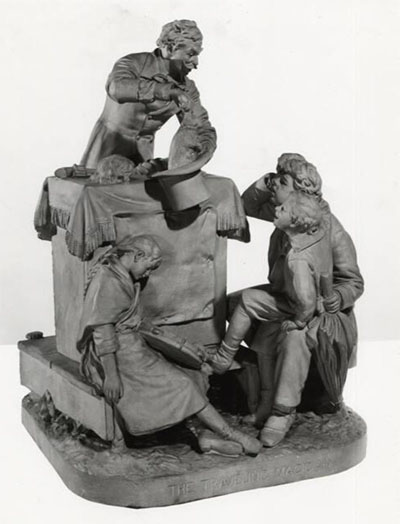
By Doug Boilesen 2023
Phonographia are popular culture connections
with the phonograph. Some
require multiple degrees of separation to make their link.
The following examples use the six
degrees of separation game where any two acquaintences can be
connected in a maximum of six steps. But this game isn't limited
to connecting people.
Using multiple links and strings
Edison's phonograph completed in 1877 can be connected with John
Rogers and his sculpture "The Traveling Magician." A connection
between Rogers and Edison is also made with the opening of the first
Kinetoscope parlor in the world in 1894 at 1155 Broadway, New York
City.
Harper's Weekly, March
30, 1878 - The Starting
Point
The March 30, 1878 issue of Harper's
Weekly included an article titled "The Phonograph"
and a full page illustration of what is looked like and how it worked.
The phonograph was described as one of "two marvels of a marvellous
age" saying if there were still those who believed in witch-craft
then those witch-hunters "would now find a "rich harvest
of victims...."
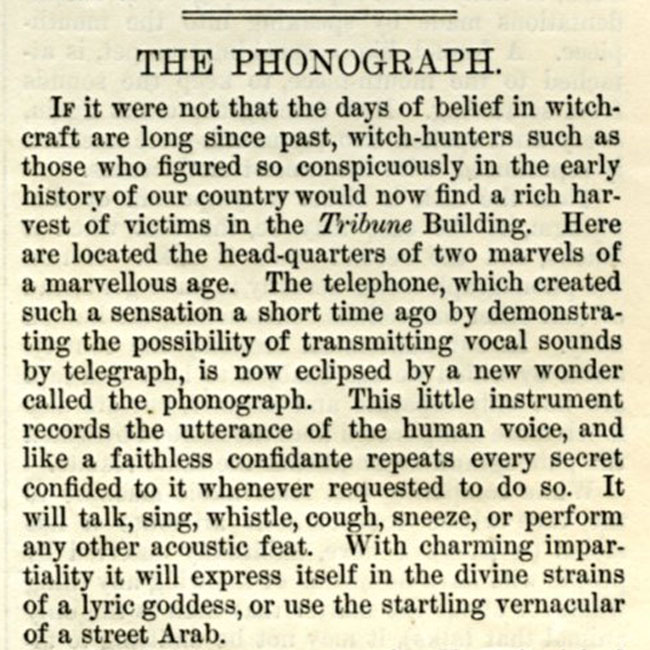
Harper's Weekly,
March 30, 1878 p. 249 (PM-1824)
A full page illustration for the article
"The Phonograph" included a depiction of the phonograph
reproducing speech to a group of people. To
see the entire article visit Phonographia's On
This Day March 30, 1878

Harper's Weekly,
March 30, 1878 p. 256
Listeners on the left of the table
look as if they are hearing the phonograph for the first time, with
the seated woman raising her hands slightly, almost in a trance
as she hears the voice. The figures on the right seem confident,
probably already having heard the phonograph and pleased that it's
working as intended for this demonstration.
This phonograph demonstration scene
reported in the March 30,1878 issue of Harper's Weekly can
be connected with John Rogers, one of the most popular sculpture
artists of the time and two of his sculpture pieces in a several
ways.
One is the advertisement for a Rogers
sculpture piece, "The Magician" which appeared the March
30, 1878 Harper's Weekly, same issue as the "The Phonograph"
article and illustration.
Another connection is between the
Rogers statuary piece "Traveling Magician" being advertised
in the Rogers' ad and Edison, the 'maker' of the phonograph being
called the "Wizard" days after "The Phonograph"
article was published.
The March 30 Harper's Weekly
issue called Edison's phonograph "a new wonder" and a
"marvel." In popular culture Edison's was recognized for
his inventing powers but he was also something of a magician. By
"bottling up sound" and replaying voices, even of those
no longer living, the phonograph left listeners amazed. Prior to
the phonograph all spoken words were ephemeral. Edison's phonograph
could reproduce a voice from a machine at the turn of the crank
-- like sound coming out of an empty hat by the hand of the magician.
On April 10, 1878 Edison would be
called the "Wizard of Menlo Park" by William Croffut in
the New York Daily Graphic. It was a name that made sense
to the public.
Additionally, the phonograph would
soon go on tours like a magicians taking their shows on the road.
When listeners heard the phonograph speak in these phonograph exhibitions
it challenged their senses like a magician challenging the eyes
of his watchers with each trick. Audiences of the phonograph might
ask "Is the phonograph really talking or is it a trick?"
"Is there a ventriloquist?" "Is someone hiding somewhere?"
In writing about the origin of Edison
being called a "Wizard" phonograph historian Allen Koenigsberg
notes:
"to the world
of the late 1870's, a wizard was still seen as a stage performer
(The first English translation of Robert-Houdinís book, How to
Become a Wizard, was all the rage), and a man who used sleight-of-hand
and trickery to achieve his results. Edison, however, saw himself
as a tireless worker in the field of electricity, telegraphy,and
mechanics who wrested his achievements from nature by persistence
and perspiration. But the choice of persona was not his alone to
makeÖ" ("How
Edison Got His Name: Origins of the Wizard" by Allen Koenigsberg,
The Sound Box, June 7, 2010, p. 19.)
Indeed, it wasn't within Edison's
powers to define who he was to his admiring public. He was the Wizard,
whether he liked it or not.
The early tin-foil Phonograph
would be exhibited throughout the country where the public would
pay to see and hear the "Miracle of the Nineteenth Century."
Edison's wizardry was confirmed by each listener of the machine
and it was rightly said in the media that Edison's wonderful invention
"never fails to excite curiosity and wonder."
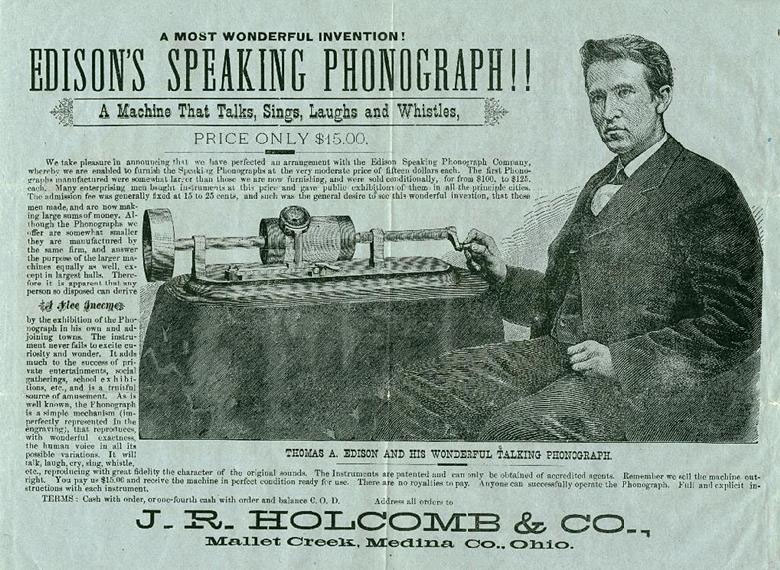
Advertising Handbill
for the Edison "Parlor" Tinfoil Phonograph, 1879 (Courtesy of René
Rondeau)
Edison himself traveled to demonstrate
to select audiences, going to New York City on December 7, 1877
and the office of Scientific American. He did the same at
Harper's Weekly in March. In April Edison went to Washington,
D.C., to the National Academy of Sciences and also demonstrated
the wonder to some skeptical members of Congress. And with a late
night visit to the White House an excited President Rutherford B.
Hayes woke up his wife to come downstairs and hear Edison's marvelous
machine.
In those early months of 1878, Edison
became the "Wizard of Menlo Park" in the press.
The traveling phonograph shows could
also have been called "The Traveling Magician."
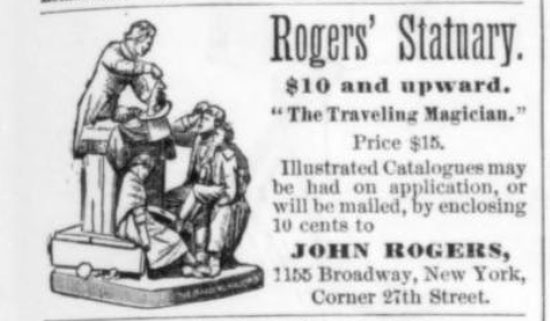
"The Traveling Magician"
advertisement, March 30, 1878 Harper's Weekly showing
1155 Broadway, New York, as the address for the John Rogers studio.
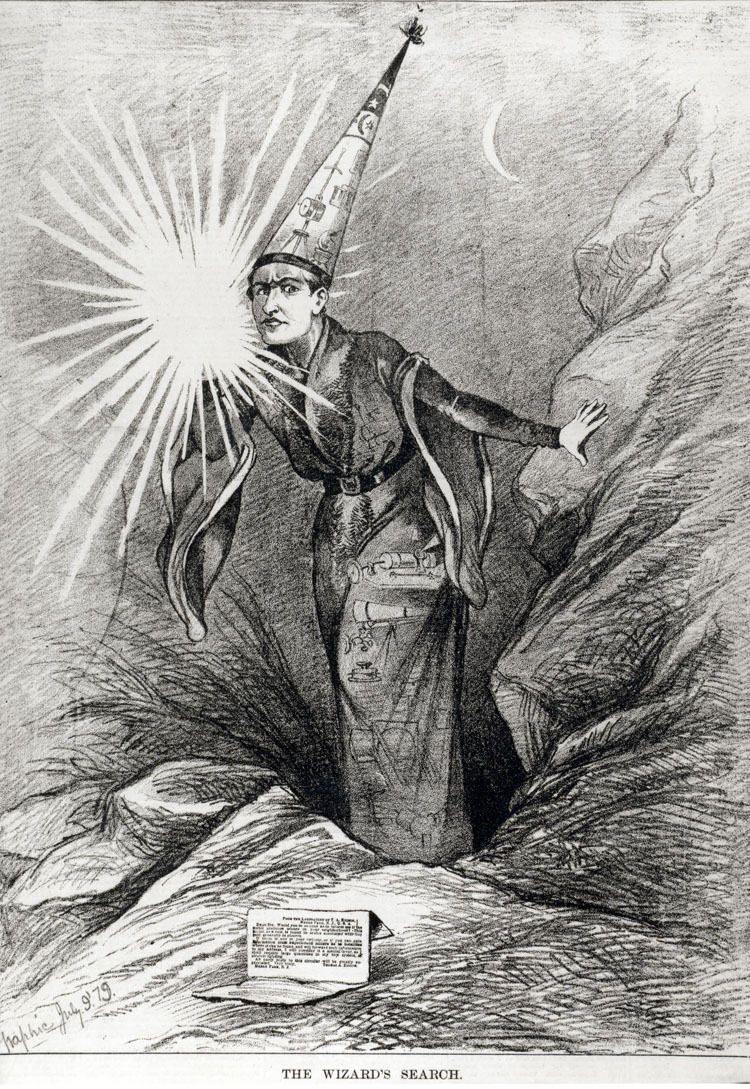
The Wizardís Search. The Daily
Graphic, An Illustrated Evening Newspaper, July 9, 1879
. 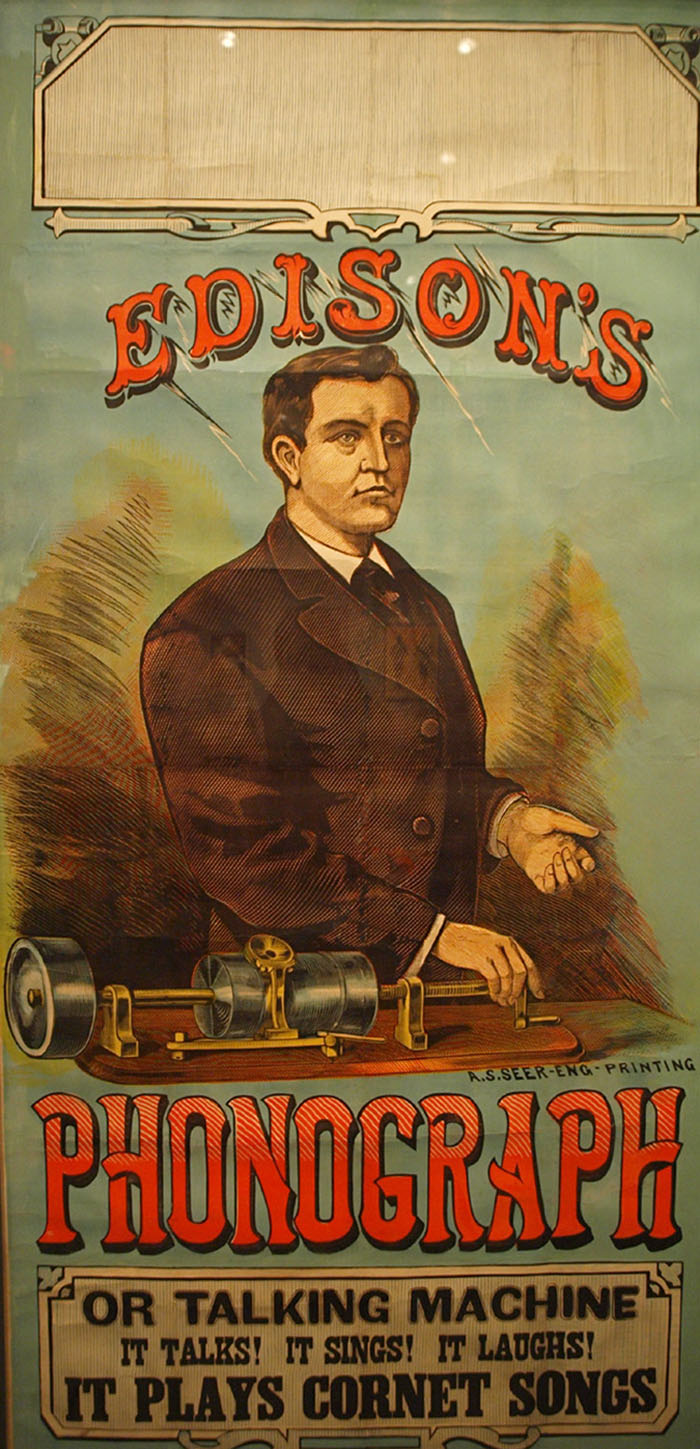
Edison's
Phonograph, 1878 - Poster
promoting demonstrations of the Phonograph (Courtesy of National Museum
of American History, Smithsonian Institution.)
Edison's tinfoil phonograph
surely could produce the sense of wonder at any of the phonograph's
traveling 'demonstrations' just like the wonder seen on the faces
of the two boys watching the rabbit come out of the hat of Rogers'
"Traveling Magician."
Another documented connection is
the 1877 date on the sculpture on the corner top of base: "JOHN
ROGERS / NEW YORK / 1877" which was also the year that Edison
completed his Phonograph ( December 6, 1877). See 1877
- the Year of the Phonograph for other popular culture examples
and context for 1877 in the United States of America.
The phonograph would first become
commercially successful as an entertainment device with the introduction
in 1889 of the Nickel-in-the-Slot
Phonograph, the earliest example of what would later be known
as the jukebox. These coin-in-the-slot "Edison Automatic
Phonographs" by the early 1890's could be heard in Phonograph
Parlors in cities through the USA.
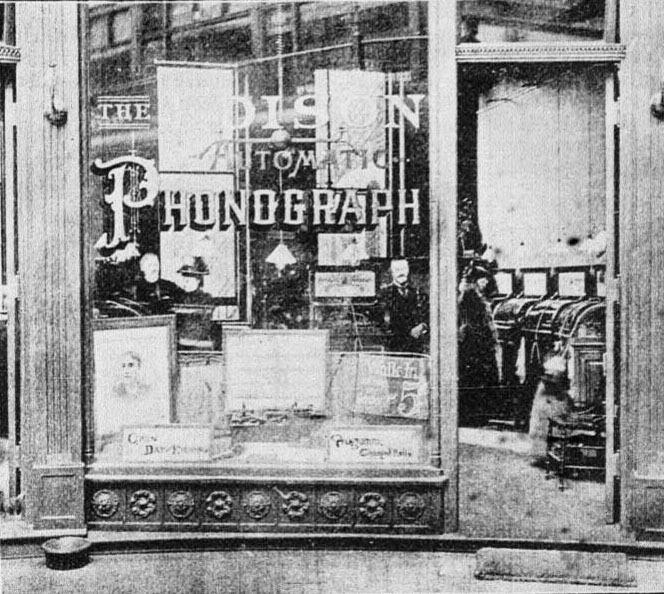
"Walk in and hear the Phonograph"
read the sign outside the Phonograph Parlor in Cleveland, Ohio,
November 1891 (The Phonogram, 1891, p. 249).
The Edison Phonograph parlors with
their coin-in-the-slot phonographs would be followed by the Edison
Kinetoscope parlors that would open in 1894 following Edison's success
in developing the Kinetoscope as a nickel-in-the-slot device to
show moving pictures through its peep hole viewer. The first Edison
Kinetoscope Parlor in the world opened in New York City on
April 14, 1894.
The Edison
Phonograph Parlors would often include kinetoscopes in their parlors
during this period of the kinetoscope's popularity before projected
moving pictures replaced the peep hole kinetoscopes.
The final example of connecting Edison
and Rogers is the location of that first Kinetoscope parlor at
1155 Broadway, New York City which was same storefront and address
where John Rogers had a studio from 1876 to 1879 and where two his
sculpture pieces "The
Traveling Magician" and "The Photograph" were made
during that time.
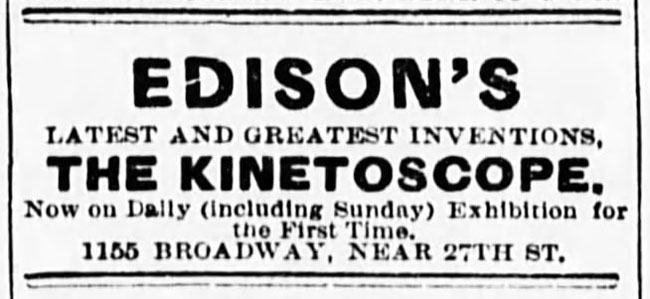
The World:Tuesday
Evening, New York, New York, May 29, 1894
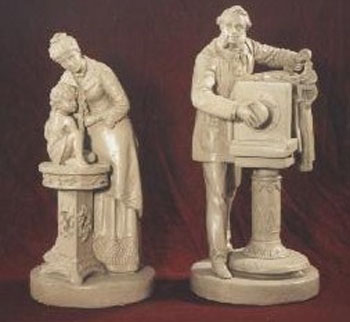
"The Photograph"
is a two-piece sculpture set in the Rogers Group, 1878.
"The Photograph" has its own connecting strings to
photography, film, moving picture film and the kinetoscope.
"The Traveling Magician"
advertisement, March 30, 1878 Harper's Weekly showing
1155 Broadway as the same address where the Edison Kinetoscope
Parlor would open in 1894.
A bust of Edison was located in
the front section of the Kinetoscope parlor at 1155 Broadway on
opening day but was soon removed. According
to Alfred O. Tate, Edison's Private Secretary, a few weeks
after the opening "I received a message from Edison asking
me to remove it. He thought it undignified."
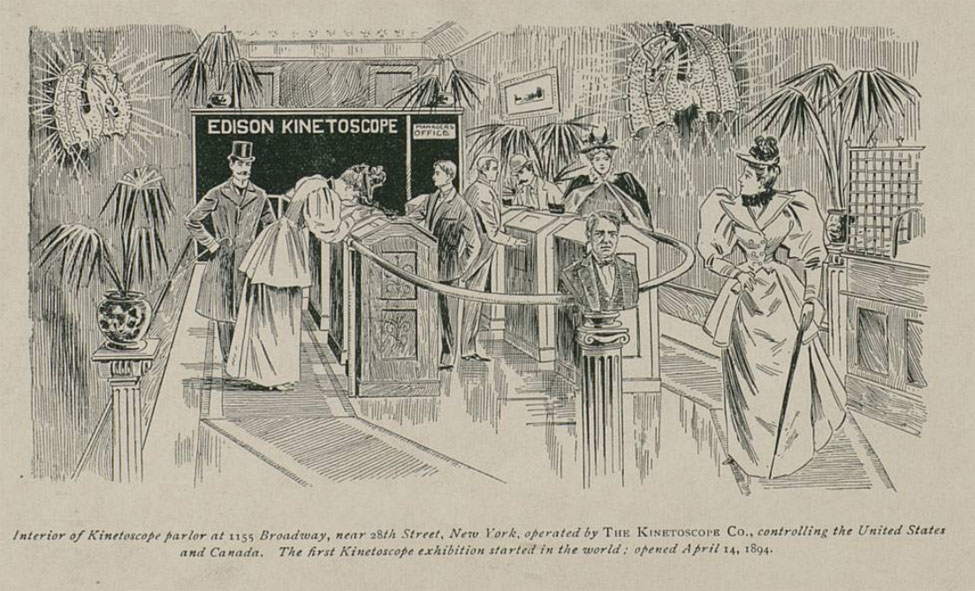
Interior of
first Kinetoscope parlor, 1155 Broadway, New York, in April
1894 (as seen in History of the Kinetograph Kinetoscope
and Phono-Kinetograph) by W. K. L. Dickson and Antonia
Dickson, p. 53 ©1895.
Summary of the connecting strings
between Edison and his Phonograph and with John Rogers, two of Rogers'
sculpture pieces, and the opening of the first Kinetoscope Parlor
in 1894.
— The March 30, 1878 Harper's
Weekly article "The Phonograph" with its illustration
and the advertisement in the same issue by John Rogers for his sculpture
piece "The Traveling Magician" are the starting points.
— The bust of Edison inside the
first Kinetoscope Parlor at 1155 Broadway was the same storefront
originally occupied by John Rogers' studio. Rogers made "The
Traveling Magician" in 1877 in that location the same year
Edison completed his Phonograph.
-- Edison's phonograph was first announced
in Harper's Weekly, March 30, 1878. In that same issue John
Rogers advertised his sculpture piece "The Traveling Magician."
This was also the same year Edison would first be called "The
Wizard of Menlo Park."
— The early phonograph demonstrations
and Edison traveling to exhibit the phonograph like a traveling
magician and John Rogers' sculpture piece "The Traveling Magician"
were taking place during the same time period when Rogers' studio
was at 1155 Broadway.
— The Edison Phonograph Parlors
have many connections with Edison Kinetoscope Parlors.
— "The Photograph"
sculpture made at Rogers' studio at 1155 Broadway was the
same address of the first Kinetoscope Parlor where the bust of Edison
was positioned in the front of that Kinetoscope Parlor in 1894.
Conclusion
Connections, interconnections, and
multiple degrees of separation can link the phonograph with people,
places, objects, ephemera, events and moments in time.
The variety of connections with the
phonograph show the numerous ways Phonographia
is defined.
Additional Footnote:
In the article "The Birthplace
of Movies" by Christopher Gray (New York Times, February
9, 1992) Gray wrote that the Kinetoscope parlor "at the southwest
corner of 27th Street was a neo-Grec style building built in 1876
where Rogers would live until at least 1879.
Gray also noted that
"the Kinetoscope was superseded only two years later by projected
motion pictures, first exhibited in 1896 at Koster & Bial's Theater
on West 34th Street...A turn-of-the-century street view shows
the 27th Street building with extensive signage for the Edison
phonograph -- presumably the Kinetoscope operation was open for
only a year or two."
|







